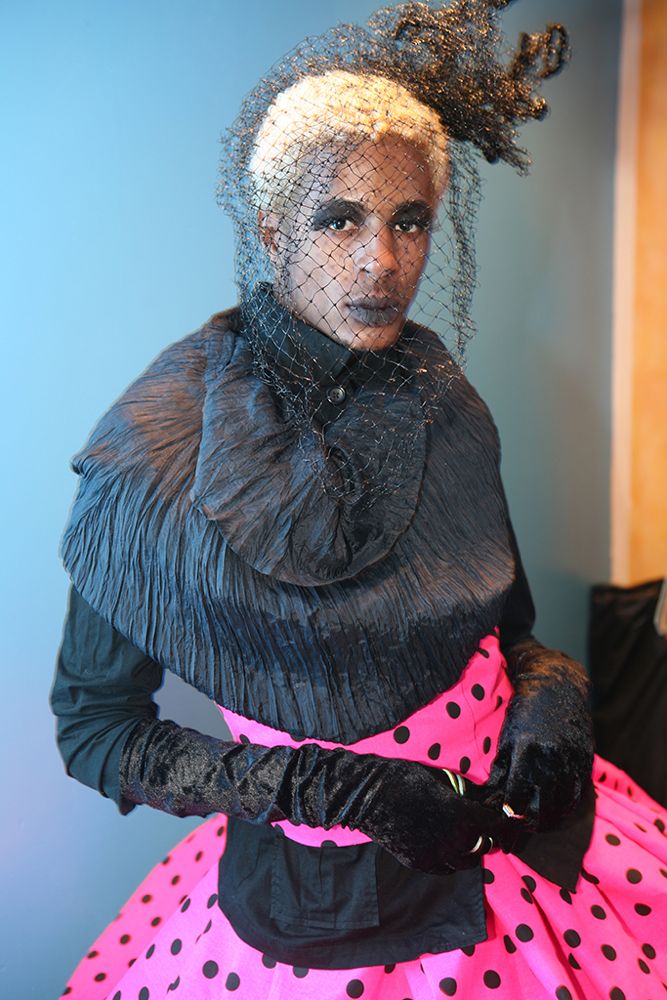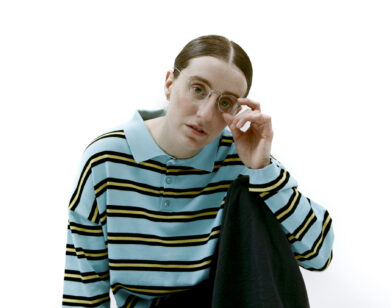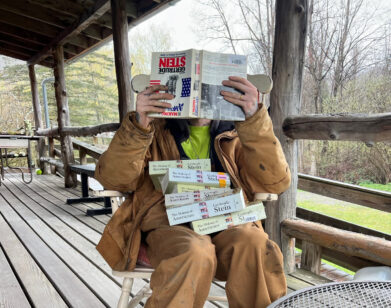Real Legends
In ballroom parlance, realness—the act of appearing so much like something (be it a woman, executive, or haute couture model) that you actually do become it—is part of the allure, glamour, and liberation of transformation.
The drag ball community in New York has been active since the 1920s. Five decades before RuPaul was sashaying and shantaying in “Supermodel (You Better Work),” drag queens would put on parties and compete for prizes for the most ornate costumes and greatest resemblance to a biological woman. In the ’70s, the contemporary ballroom scene expanded to include categories for gay men not in drag (“butch queens”) and the formation of houses (the idea borrowed from borrowed from fashion’s maisons), tight-knit groups who would prepare and compete together, usually led by one veteran in the community. Among the most prominent houses were St. Laurent, Xtravaganza, Mizrahi, and Ninja, all of which would battle against each other in categories such as Butch Queen Realness, Face, Runway, Model’s Body, and Vogue Femme.
Whether for a minute on a runway or in an inexorable fantasy, individuals have captivated not merely by giving good “face,” but by crafting an outfit with enough ingenuity and working the catwalk with enough attitude to nab top prize. Brought into the mainstream collective consciousness with Jennie Livingston’s 1990 documentary Paris Is Burning and Madonna’s “Vogue” music video, the ball scene has endured, growing and evolving into a global happening.
Beginning December 1, in honor of World AIDS Day, the W New York will present “Legends,” a month-long photographic exhibition and charity initiative celebrating the New York ballroom scene. Curated by Gerard H. Gaskin, who has been documenting the ball scene for over two decades, the exhibition will feature archival works and never-before-seen images of the next generation of the ballroom community excerpted from Gaskin’s debut book Legendary. The W will also provide a special travel package, with proceeds going to the Hetrick-Martin Institute, an organization providing social care for at-risk LGBT youth across New York City.
Interview recently spoke with Hector Xtravaganza, founding member and now grandfather of the House of Xtravaganza, and Jack Mizrahi, emcee and “voice of the Ballroom scene,” who also consulted on the exhibition. We will debut a new photo from W’s exhibition each day for the next five days, so please check back for more from “Legends.”
COLLEEN KELSEY: I want to start at the very beginning. Could you tell me a bit about how you first got into the ball scene?
HECTOR XTRAVAGANZA: Well the first time I went to a ball was with [drag legend] Dorian Corey—she’s like my gay auntie. She took me to the first one, and that was in I think 1980. As far as The Xtravaganzas, we have been family before we even gave ourselves the name. You know, we gave ourselves the other name in ’82, but we were together before that, and to this very day we are still together. Honestly speaking, we’ve been fashionistas from the beginning. The first time was like going into the lion’s den. It was all about being creative: go home, find things in the house and make an outfit. Go to the ball and turn it out, collaborate with one another. We were always creative, because 90% of us were homeless from the beginning, so we had no choice but to be creative, we couldn’t afford anything. I learned once you hit the runway you have two options. You turn it out— you eat the runway, you own the runway—or you fail. So knowing there were only two options, we had to choose the right one, and the right one was the best one.
JACK MIZRAHI: I went to a club and I met Andre Mizrahi. I never heard of anything, this was like my second night in the gay club, period, so I was really sheltered. When he gave me the flyer I was like, “What is this?” and it was just a basic two-fold, black and white flyer that said “Legends Ball.” When the event came, which was maybe like three months down the road, it was on a Sunday afternoon at Tracks at 19th Street. It said the doors open at 3, so I get there at 3 and there is a sign on the door saying, “Ball won’t start till 5.” So I end up going to the movies and I walk back over there, but to make a long story short, the ball actually did not start ’till 12. But by this time people were filing in, and these were people I’ve never seen before, but it just looked like something great was about to happen, you just could feel it. People were coming in with garment bags, and there were these beautiful women, which I would later find out are the transsexual girls of the community. Once they were ready to start, a voice came over the loudspeaker and started to make the introductions. It was probably just one of the most eye-opening experiences. I stayed there from 3 o’clock in the afternoon; I didn’t get home till the next day at 6 a.m.
I had just gotten out of high school and I used to be a freelance photographer for a couple of pro-wrestling magazines. Even at school, I was pretty good and pretty popular and people knew me, but there was just something that was missing in who I was then as to who I would become and who I am now. Coming into that night on May 3, 1992, walking into that ballroom and then staying and watching the whole thing, I never thought my life would change like this. I never thought that I would have a stage, a place where I could become someone, and be now revered by so many other people. So it was such a great eye-opening, and I would say life-saving, experience for me.
KELSEY: And do you remember the first time that you walked and what you were wearing?
MIZRAHI: I actually walked the following week. We went to Philadelphia to a mini ball, and I walked the category called Linen vs. Silk. I was put in the house to walk Face and at that time, the way it was and the way people had so much fun at balls is that you walk multiple categories, you got prepared for as many as you can walk. As Andre was starting the new house, he encouraged us. I actually won “Realest” trophies at three major balls, but that was my first ball. I had on a simple white linen outfit, 100 percent linen, by Liz Claiborne, and I won.
XTRAVAGANZA: The first category I walked in a ball was Model’s Body vs. Muscular. Back then, it was different than it is now. Now they want you ripped, you have to have the cuts and all, but model’s body back then you had to be slender and tender for your gender. You had to be nice and slim. I had to go out basically in a bathing suit. Once I walked, from there it escalated. Once I mastered that one, I went to my next one, my next one, and my next one. Then it just became who I was.
KELSEY: Attaining legendary status is the ultimate achievement. What qualities do you consider to make a person legendary? And who, in your opinion, is a legend?
MIZRAHI: Back then if you became a legend, you really didn’t know it. You knew that you were on a winning streak, you felt that people knew who you were, you felt your competitors once you walked into a ballroom—you could see the shift in the face of your competitors at the house table. When you see that, that’s when you start getting the inclination. Now, people are actually protesting to be legend, “I have been walking 10 years, I’ve been walking 15 years.” So legendary for me, when you walk into it, you feel it, it is like you wear it automatically. You have arrived. It really is more of a feeling. There’s a lot of people out there that have been in scene for well over 20 years, 30 years, who are not legendary for a particular category. They are not legendary for being known to win Grand Prize Face, or Grand Prize Vogue. For us, it is definitely about the win and the value that you put into the category and into the scene.
XTRAVAGANZA: Hall of Famer is like the ultimate, but that takes time. I am finding a lot of kids just becoming legendary overnight, which I don’t understand, honestly speaking. But that’s the way the balls are today. As far as being a Hall of Famer, it’s whether you are contributing to the ballroom scene. Like myself personally, I am in tune with three generations, because there are three generations in the ballroom scene, I am in tune with all three. I am grandfather and godfather of other houses as well as Xtravaganza. I look at it in a whole different perspective than everybody else, because I am very real with everything; you don’t have to be in my house to be my grandchild. I look at it in a biological sense.
KELSEY: Was there anyone that you looked up to in the community when you were first starting out?
MIZRAHI: I was blessed. I was able to see three generations of ballroom. Around the time that I came out, the older guard who were just coming out of Paris Is Burning, Octavia St. Laurent, Danielle Revlon. There was a lot of people that I was able to learn from who are no longer [around], because within three years of myself being injected into the scene, the people that I met and saw on stage early May 3, 1992, I would say at least 60% of them had passed away by that same summer in 1995, 1996. So I was able to learn and meet Avis Pendavis and compete against Avis Pendavis. I was able to talk and learn from Paris DuPree as well as Andre Mizrahi. I was one of the last groups of people that got to get that last schooling from [the] elders.
KELSEY: Obviously New York was a very different place than it was in the ’80s and the early ’90s, when you were first starting out. How have things in the scene changed? I imagine things are much bigger now, especially with the Internet.
XTRAVAGANZA: From the ’80s and the ’90s, it has expanded worldwide. It is no joke now. It is very, very serious. You have kids coming here from Japan, kids coming here from Germany, kids coming here from Paris, kids coming here from Russia to compete. I have been to those places, and I have seen the competition there. I also do Q&As when I go there. I am curious myself because basically my Q&As go both ways. That way, when I come back here I come with perspective of what’s going on over there. I feel that it has expanded and it is expanding more and more. One day there is going to be an international ball competition.
MIZRAHI: It is grander now, but there are two major differences I can see. Number one is the fact that now, [being] gay is so much more acceptable. Back then, you looked at the scene as a place to fit in because the world wasn’t ready for you or you couldn’t come out to your family. Or because you came out to your family and you were pushed more into the scene because your family didn’t want nothing to do with you. But then, here, you have a plethora of people who just adore you and are behind you for you to win, win, win. And now with gay being much more popularized, that saying that everybody fits in, or everybody is respected, I think the pressure of where I couldn’t work back then, or I couldn’t be myself back then, is not the same anymore. Now, people are coming into the ballroom scene are getting their confidence faster because it wasn’t ever compromised. It is not suffocated as much as I think most of the people’s [confidence] back in the early ’80s and ’90s were. We are freer now.
KELSEY: Jack, I know you are an emcee for balls, and Hector, you’ve been a judge. What makes a contestant stand out?
XTRAVAGANZA: I am always looking for something different, because sometimes, like Vogue Femme, that could be like a two-hour category and you have 50 million kids doing the same thing. I get bored. So you have to give me something, make me “Wow.” If you’re not going make me wow, then I am going to have to chop you. I just want everyone to know that once you are stepping on the runway, you are already a winner because it takes a lot of guts to step on a runway. We scrutinize up and down and all around.
MIZRAHI: Attitude is probably one of the most underestimated things in the world. Like they always say, attitude can get you anywhere. You can have someone dress up in complete Roberto Cavalli and then next to them you have somebody in just a plain old something from the Gap, but the person with the Gap outfit on has so much attitude and so much conviction that makes a contestant stand out because they know before they are even judged that they are grand prize winners. That goes a long way.
KELSEY: Do you have a favorite category?
MIZRAHI: I love the way the ballroom scene was basically started because of transgendered women. I love that when you see them come out there for Face and Realness that they are letting this side of them come through. They are generally beautiful people on the inside, and the outside, and in their presence just the whole attitude of it, they become our celebrities. They become our Jennifer Lopez, and our Beyoncé, when they hit the back of that runway. I love to see the metamorphosis.
KELSEY: Jack, how did you come on board for the W’s exhibition?
MIZRAHI: Well, last year I did the LOVE Hangover Ball for The W Hotels with Josh Wood Productions. I have always been great friends with Gerard Gaskin. I have always admired his work. Every time we see him at a ball for the last 25 years and it felt like almost a natural fit. The W came in and said, “You know what, let me showcase this talent.” You know, I can just imagine the clientele [of the W] to be so shocked to know that something was right under their nose all this time in New York City, and is spreading all across the country, and now all over the world. It is a beautiful and honoring moment for our community.
KELSEY: Hector, what was your reaction when you found out about the exhibition?
XTRAVAGANZA: For me, this is so surreal. That was a grand prize on its own, legendary on its own. The W is really doing something that is so amazing and out of the box. I appreciate it with all my heart and I support it. I know the ballroom scene is probably gonna freak out.
KELSEY: And what do you want people to learn or walk away with from the exhibition?
MIZRAHI: I want them to know that what the ballroom scene has done for a lot of people and will continue to do—giving people a voice. It has given us a voice, it has given us a place where in the past we were shunned and were pushed to the side, and we were regulated to only being the background players, the makeup artists, the stylists. The ballroom scene had given a confidence and an air of authority. If you have talent, your talent will work for you. Explore your talent, learn your craft, and you can get better, bigger, and greater at it. And I think that is exactly what the ballroom scene does for the kids, it amplifies our personalities, it amplifies our talent. A lot of these kids that come to the scene with everything that they are facing, from the health crisis of HIV, with younger kids getting more exposed to it, it is a place for us to come, and we mourn our friends but at the same time we live and we celebrate one another.
LEGENDS WILL LAUNCH SUNDAY, DECEMBER 1ST AT THE W NEW YORK. TO LEARN MORE ABOUT LEGENDS, VISIT THE W’S WEBSITE.







